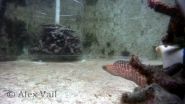(Press-News.org) The conversion of forests into cropland worldwide has triggered an atmospheric change that, while seldom considered in climate models, has had a net cooling effect on global temperatures, according to a new Yale study.
Writing in the journal Nature Climate Change, Professor Nadine Unger of the Yale School of Forestry & Environmental Studies (F&ES) reports that large-scale forest losses during the last 150 years have reduced global emissions of biogenic volatile organic compounds (BVOCs), which control the atmospheric distribution of many short-lived climate pollutants, such as tropospheric ozone, methane, and aerosol particles.
Using sophisticated climate modeling, Unger calculated that a 30-percent decline in BVOC emissions between 1850 and 2000, largely through the conversion of forests to cropland, produced a net global cooling of about 0.1 degrees Celsius. During the same period, the global climate warmed by about 0.6 degrees Celsius, mostly due to increases in fossil fuel carbon dioxide emissions.
According to her findings, the climate impact of declining BVOC emissions is on the same magnitude as two other consequences of deforestation long known to affect global temperatures, although in opposing ways: carbon storage and the albedo effect. The lost carbon storage capacity caused by forest conversion has exacerbated global warming. Meanwhile, the disappearance of dark-colored forests has also helped offset temperature increases through the so-called albedo effect. (The albedo effect refers to the amount of radiation reflected by the surface of the planet. Light-colored fields, for instance, reflect more light and heat back into space than darker forests.)
Unger says the combined effects of reduced BVOC emissions and increased albedo may have entirely offset the warming caused by the loss of forest-based carbon storage capacity.
"Land cover changes caused by humans since the industrial and agricultural revolutions have removed natural forests and grasslands and replaced them with croplands," said Unger, an assistant professor of atmospheric chemistry at F&ES. "And croplands are not strong emitters of these BVOCs — often they don't emit any BVOCs."
"Without doing an earth-system model simulation that includes these factors, we can't really know the net effect on the global climate. Because changes in these emissions affect both warming and cooling pollutants," she noted.
Unger said the findings do not suggest that increased forest loss provides climate change benefits, but rather underscore the complexity of climate change and the importance of better assessing which parts of the world would benefit from greater forest conservation.
Since the mid-19th century, the percentage of the planet covered by cropland has more than doubled, from 14 percent to 37 percent. Since forests are far greater contributors of BVOC emissions than crops and grasslands, this shift in land use has removed about 30 percent of Earth's BVOC sources, Unger said.
Not all of these compounds affect atmospheric chemistry in the same way. Aerosols, for instance, contribute to global "cooling" since they generally reflect solar radiation back into space. Therefore, a 50 percent reduction in forest aerosols has actually spurred greater warming since the pre-industrial era.
However, reductions in the potent greenhouse gases methane and ozone — which contribute to global warming — have helped deliver a net cooling effect.
These emissions are often ignored in climate modeling because they are perceived as a "natural" part of the earth system, explained Unger. "So they don't get as much attention as human-generated emissions, such as fossil fuel VOCs," she said. "But if we change how much forest cover exists, then there is a human influence on these emissions."
These impacts have also been ignored in previous climate modeling, she said, because scientists believed that BVOC emissions had barely changed between the pre-industrial era and today. But a study published last year by Unger showed that emissions of these volatile compounds have indeed decreased. Studies by European scientists have produced similar results.
The impact of changes to ozone and organic aerosols are particularly strong in temperate zones, she said, while methane impacts are more globally distributed.
The sensitivity of the global climate system to BVOC emissions suggests the importance of establishing a global-scale long-term monitoring program for BVOC emissions, Unger noted.
INFORMATION: END
Yale study shows how conversion of forests to cropland affected climate
Seldom considered BVOC emissions have net cooling impact
2014-09-08
ELSE PRESS RELEASES FROM THIS DATE:
Brain damage caused by severe sleep apnea is reversible
2014-09-08
DARIEN, IL – A neuroimaging study is the first to show that white matter damage caused by severe obstructive sleep apnea can be reversed by continuous positive airway pressure therapy. The results underscore the importance of the "Stop the Snore" campaign of the National Healthy Sleep Awareness Project, a collaboration between the Centers for Disease Control and Prevention, American Academy of Sleep Medicine, Sleep Research Society and other partners.
Results show that participants with severe, untreated sleep apnea had a significant reduction in white matter fiber integrity ...
A bird-pollinated flower with a rather ingenious twist
2014-09-08
VIDEO:
When a bird forages on nectar, the flower twists as the spur complies with the shape of the
bird's bill. In consequence, pollen is placed in an unusual location on...
Click here for more information.
When researchers studying several bird-pollinated species of Impatiens flowers in the mountains of western Cameroon noticed one with an odd, upwardly curving nectar spur, they couldn't imagine how any sunbird could ever sip from it. After recording visitors to the flower continuously ...
Coral trout pick their collaborators carefully
2014-09-08
VIDEO:
Coral trout are choosey about moray collaborators.
Click here for more information.
Coral trout not only work with moray eels to improve their chances of a meal, but they can also be choosy when it comes to picking the best moray partner. The findings reported in the Cell Press journal Current Biology on September 8 show that such sophisticated collaborative abilities are not limited to apes and humans.
The fish's behavior is remarkable in other ways too, the researchers ...
Fish as good as chimpanzees at choosing the best partner for a task
2014-09-08
Coral trout are fast when chasing prey above the reefs of their habitat, but can't pursue their quarry if it buries itself into a hard-to-reach reef crevice.
When this happens, the trout will team up with a snake-like moray eel to flush out the unfortunate fish in a remarkable piece of interspecies collaboration: either the eel takes the prey in the reef, or scares it back into the open so the trout can pounce.
Coral trout - along with close relative the roving coral grouper - will use gestures and signals to flag the location of prey to an eel, including head shakes ...
Hog workers carry drug-resistant bacteria even after they leave the farm
2014-09-08
A new study suggests that nearly half of workers who care for animals in large industrial hog farming operations may be carrying home livestock-associated bacteria in their noses, and that this potentially harmful bacteria remains with them up to four days after exposure.
Researchers had believed that livestock-associated bacteria would clear from the noses of hog workers quickly – within 24 hours. But this small study of hog workers in North Carolina, reported online Sept. 8 in the journal Occupational and Environmental Medicine, suggests it can stick around longer. ...
Popular cancer drug target implicated in cardiovascular defects
2014-09-08
September 8, 2014 CHAPEL HILL – UNC School of Medicine researchers have discovered an unlikely relationship between CXCR7 – a protein implicated in tumor growth and metastasis – and adrenomedullin – a hormone involved in cardiovascular health. Deleting CXCR7 allows adrenomedullin to run rampant, triggering the development of an enlarged heart and the overgrowth of the lymphatic vessels that traffic immune cells and fluids throughout the body.
The study, published September 8 in the journal Developmental Cell, reveals that CXCR7 binds to the ligand adrenomedullin. The ...
UNC researchers find new genetic target for a different kind of cancer drug
2014-09-08
CHAPEL HILL, NC – Researchers from the UNC School of Medicine have discovered that the protein RBM4, a molecule crucial to the process of gene splicing, is drastically decreased in multiple forms of human cancer, including lung and breast cancers. The finding, published today in the journal Cancer Cell, offers a new route toward therapies that can thwart the altered genetic pathways that allow cancer cells to proliferate and spread.
"Historically, scientists haven't targeted the proteins in cancer cells that are involved in gene splicing," said Zefeng Wang, PhD, associate ...
Scientists apply biomedical technique to reveal changes in body of the ocean
2014-09-08
For decades, doctors have developed methods to diagnose how different types of cells and systems in the body are functioning. Now scientists have adapted an emerging biomedical technique to study the vast body of the ocean.
In a paper published this week in the journal Science, scientists demonstrate that they can identify and measure proteins in the ocean, revealing how single-celled marine organisms and ocean ecosystems operate.
The National Science Foundation (NSF) and the Gordon and Betty Moore Foundation funded the research.
"Proteins are the molecules that catalyze ...
Faces are more likely to seem alive when we want to feel connected
2014-09-08
Feeling socially disconnected may lead us to lower our threshold for determining that another being is animate or alive, according to new research published in Psychological Science, a journal of the Association for Psychological Science.
"This increased sensitivity to animacy suggests that people are casting a wide net when looking for people they can possibly relate to — which may ultimately help them maximize opportunities to renew social connections," explains psychological scientist and lead researcher Katherine Powers of Dartmouth College.
These findings enhance ...
Bone cancer surgical team sees success in new application of surgical aid
2014-09-08
(9/8/14, Lebanon, NH) —An ortho-oncology team at Dartmouth-Hitchcock Norris Cotton Cancer Center successfully adapted a shoulder surgical aid (the Spider Limb Positioner) to conduct a left hip disarticulation on a melanoma patient as described in a case report published online in Medical Devices.
The Spider Limb Positioner is a pneumatic arm with three fully articulating joints that can be infinitely adjusted in relation to the operating table where it is mounted. The positioner mobilizes patients' limbs so surgeons don't have to, thereby freeing up both their hands ...
LAST 30 PRESS RELEASES:
Numbers in our sights affect how we perceive space
SIMJ announces global collaborative book project in commemoration of its 75th anniversary
Air pollution exposure and birth weight
Obstructive sleep apnea risk and mental health conditions among older adults
How talking slows eye movements behind the wheel
The Ceramic Society of Japan’s Oxoate Ceramics Research Association launches new international book project
Heart-brain connection: international study reveals the role of the vagus nerve in keeping the heart young
Researchers identify Rb1 as a predictive biomarker for a new therapeutic strategy in some breast cancers
Survey reveals ethical gaps slowing AI adoption in pediatric surgery
Stimulant ADHD medications work differently than thought
AI overestimates how smart people are, according to HSE economists
HSE researchers create genome-wide map of quadruplexes
Scientists boost cell "powerhouses" to burn more calories
Automatic label checking: The missing step in making reliable medical AI
Low daily alcohol intake linked to 50% heightened mouth cancer risk in India
American Meteorological Society announces Rick Spinrad as 2026 President-Elect
Biomass-based carbon capture spotlighted in newly released global climate webinar recording
Illuminating invisible nano pollutants: advanced bioimaging tracks the full journey of emerging nanoscale contaminants in living systems
How does age affect recovery from spinal cord injury?
Novel AI tool offers prognosis for patients with head and neck cancer
Fathers’ microplastic exposure tied to their children’s metabolic problems
Research validates laboratory model for studying high-grade serous ovarian cancer
SIR 2026 delivers transformative breakthroughs in minimally invasive medicine to improve patient care
Stem Cell Reports most downloaded papers of 2025 highlight the breadth and impact of stem cell research
Oxford-led study estimates NHS spends around 3% of its primary and secondary care budget on the health impacts of heat and cold in England
A researcher’s long quest leads to a smart composite breakthrough
Urban wild bees act as “microbial sensors” of city health.
New study finds where you live affects recovery after a hip fracture
Forecasting the impact of fully automated vehicle adoption on US road traffic injuries
Alcohol-related hospitalizations from 2016 to 2022
[Press-News.org] Yale study shows how conversion of forests to cropland affected climateSeldom considered BVOC emissions have net cooling impact


